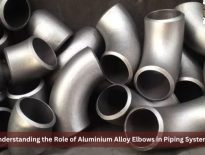In the marine industry, materials must withstand harsh environmental conditions while delivering performance, longevity and efficiency. Among the various materials available, aluminum angles have grown in popularity and are frequently utilized in shipbuilding, offshore structures, and coastal infrastructure. But what makes aluminum angles so suitable for the marine industry? Let’s look at the main reasons for their widespread preference.
What are aluminium alloy angles?
Aluminium Alloy Angles are L-shaped metal sections made from marine-grade aluminium. They are available in a variety of sizes and thicknesses depending on their intended application. These angles are often produced using grades like 5083, 6061, and 6082. The L-shape gives support to edges and corners in structures.
They are widely used in many industries, but their role in marine projects is especially important. From shipbuilding to dock framing, Aluminium Alloy Angles help hold things together while keeping weight low.
Key Properties That Make Aluminium Angles Ideal for Marine Use
Corrosion Resistance in Saltwater Environments
Saltwater may corrode and degrade most metals over time, but Aluminium Alloy 1100 Angle handles this well because it generates a natural oxide layer that protects against corrosion, requiring less maintenance and lasting longer.
When compared to mild steel, Aluminium Alloy 1100 lasts much longer in marine air and water, as it creates extra coatings to add more protection. This makes Aluminium Alloy 1100 Angle useful for both above-water and underwater parts.
Lightweight Yet Strong
One of the biggest advantages of aluminium is its strength-to-weight ratio. It’s about one-third the weight of steel, yet strong enough to support heavy loads.
Lightweight ships are significant in marine applications because they utilize less fuel. Reduced weight relieves stress on joints and moving parts. It allows designers to create solid structures without adding unnecessary mass.
Ease of Fabrication and Welding
Aluminium Alloy Angles are easy to work with as they can be cut, shaped, drilled and welded without much trouble. This is helpful during repairs or new construction.
Whether used in shipyards or docks, aluminium can be adapted on-site. It does not need special tools or slow procedures, which makes the work faster and lowers labour costs.
Thermal and Electrical Conductivity
Aluminium is also good at conducting heat and electricity as it is useful in some marine systems especially near engines or electrical panels.
Angles may be used to support systems that transfer heat or power. They help keep the setup safe and efficient, even in wet environments.
Common Applications in the Marine Industry
Aluminium Alloy Angles are commonly used in marine constructions because of their design and properties which make them appropriate for various parts of a vessel or port.
Structural Frameworks: They are often used to create strong frameworks for ships and boats. These frames support decks, walls, and other parts.
Boat Hull Reinforcements: Angles are used to strengthen hulls. They add support to the shape of the boat and reduce vibration during movement.
Railing and Ladder Supports: They provide a solid base for railings and ladders as aluminium is safe to grip even in wet conditions.
Storage Racks and Partitions: Aluminium angles are used to make racks for tools and supplies as their rust resistance is helpful in damp spaces.
Dock Construction and Edge Guards: They are often installed along dock edges to prevent wear and tear. They also offer support under ramps and loading areas.
Underwater Fittings: Some aluminium alloys are suited for underwater use. Angles made from such alloys are found in pontoons, floating platforms, and anchor structures.
Comparison with Other Marine Metals
Several metals are used in the marine sector but aluminium angles stand out due to a unique mix of advantages.
Aluminium vs. Stainless Steel
Weight: Aluminium is much lighter, improving fuel efficiency and ease of handling.
Corrosion Resistance: Both metals resist corrosion, but aluminium forms a natural oxide layer needing less upkeep.
Cost and Fabrication: Aluminum is cost-effective and easier to work with than stainless steel.
Aluminium vs. Brass
Strength: Brass is softer and unsuitable for load-bearing structures.
Durability: Brass may weaken in seawater due to dezincification, while aluminium remains stable.
Weight: Aluminium is lighter and helps in vessel performance.
Aluminium vs. Carbon Steel
Corrosion: Carbon steel rusts quickly and needs constant protection; aluminium resists saltwater naturally.
Maintenance: Aluminum takes less maintenance and lasts longer in the marine climate.
Weight: Aluminium’s lower weight reduces structural strain and fuel use.
Industry Standards and Grades for Marine Aluminium Angles
Some grades of aluminium are made just for marine use. These include:
- 5083-H111: High strength and top corrosion resistance, commonly used in shipbuilding.
- 6061-T6: Strong and easy to weld and used in structural and support parts.
- 6082-T6: Great for load-bearing structures and offers strength and resistance to wear.
Standards like ASTM B221 and ISO 6361, help ensure that aluminium products meet marine safety rules. Buyers should check for these marks before use.
Sustainability and Lifecycle Benefits
Aluminium is 100% recyclable as it can be melted and reused without losing quality. This makes it a fantastic choice for eco-friendly projects.
Marine-grade aluminum is long-lasting even after years of use as it maintains its shape and strength. Once removed, it can be recycled into new parts. This lowers waste and supports sustainable goals.
Choosing the Right Aluminium Alloy Angle for Marine Use
When choosing an aluminum angle for marine applications, it’s crucial to consider aspects like the alloy type, ensure it’s marine-grade, such as 5083 or 6082, for maximum performance, as well as the proper thickness to sustain expected loads. Protective coatings such as anodizing or marine paint can enhance the lifespan in a saltwater environment. To avoid using inferior materials, reliable performance requires buying from certified and competent sources. Consulting with industry specialists ensures that you select the appropriate grade, size, and finish for safe, long-term use at sea.
Conclusion
Aluminum Alloy Angles have numerous advantages in marine building. They resist corrosion, weigh less, and remain strong under pressure. Their ease of use and long life make them a better option over other metals.
For marine projects that demand reliability and cost control, aluminium angles are the clear choice. Whether for docks, ships or boat parts, they provide lasting performance in harsh sea environments.



